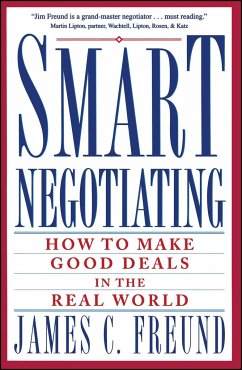16,99 €
inkl. MwSt.
Versandfertig in über 4 Wochen

8 °P sammeln
- Broschiertes Buch
- Merkliste
- Auf die Merkliste
- Bewerten Bewerten
- Teilen
- Produkt teilen
- Produkterinnerung
- Produkterinnerung
The four vital steps for successful negotiation--explained with wit and clarity by a master negotiator. Using examples from his own broad range of negotiating experiences, Freund presents a "game-plan" approach to negotiating--a technique far more successful than hardball competition or win-win cooperation.
Andere Kunden interessierten sich auch für
![Negotiating With Agility Negotiating With Agility]() Kathy BeyerchenNegotiating With Agility25,99 €
Kathy BeyerchenNegotiating With Agility25,99 €![Negotiate Like a CEO Negotiate Like a CEO]() Jotham SteinNegotiate Like a CEO20,99 €
Jotham SteinNegotiate Like a CEO20,99 €![Negotiating Genuinely Negotiating Genuinely]() Shirli KopelmanNegotiating Genuinely15,99 €
Shirli KopelmanNegotiating Genuinely15,99 €![Power Negotiating for Salespeople Power Negotiating for Salespeople]() Roger DawsonPower Negotiating for Salespeople15,99 €
Roger DawsonPower Negotiating for Salespeople15,99 €![Translating Business Negotiations into Law Translating Business Negotiations into Law]() Linda FrazerTranslating Business Negotiations into Law36,99 €
Linda FrazerTranslating Business Negotiations into Law36,99 €![Start Your Own Corporation Start Your Own Corporation]() Garrett SuttonStart Your Own Corporation22,99 €
Garrett SuttonStart Your Own Corporation22,99 €![The Manager's Guide to HR The Manager's Guide to HR]() Max MullerThe Manager's Guide to HR18,99 €
Max MullerThe Manager's Guide to HR18,99 €-
-
-
The four vital steps for successful negotiation--explained with wit and clarity by a master negotiator. Using examples from his own broad range of negotiating experiences, Freund presents a "game-plan" approach to negotiating--a technique far more successful than hardball competition or win-win cooperation.
Hinweis: Dieser Artikel kann nur an eine deutsche Lieferadresse ausgeliefert werden.
Hinweis: Dieser Artikel kann nur an eine deutsche Lieferadresse ausgeliefert werden.
Produktdetails
- Produktdetails
- Verlag: Simon & Schuster
- Seitenzahl: 256
- Erscheinungstermin: 8. Juni 1993
- Englisch
- Abmessung: 214mm x 139mm x 17mm
- Gewicht: 299g
- ISBN-13: 9780671869212
- ISBN-10: 0671869213
- Artikelnr.: 22073364
- Herstellerkennzeichnung
- Libri GmbH
- Europaallee 1
- 36244 Bad Hersfeld
- gpsr@libri.de
- Verlag: Simon & Schuster
- Seitenzahl: 256
- Erscheinungstermin: 8. Juni 1993
- Englisch
- Abmessung: 214mm x 139mm x 17mm
- Gewicht: 299g
- ISBN-13: 9780671869212
- ISBN-10: 0671869213
- Artikelnr.: 22073364
- Herstellerkennzeichnung
- Libri GmbH
- Europaallee 1
- 36244 Bad Hersfeld
- gpsr@libri.de
A prominent negotiator in many of the major corporate takeover battles of the 1980s -- from TWA to Federated Department Stores -- James C. Freund is a senior partner at the eminent New York law firm of Skadden, Arps, Slate, Meagher & Flom, as well as an adjunct professor at Fordham Law School, where he teaches a course in negotiating. He lives in New York City.
CONTENTS
BY WAY OF INTRODUCTION
Building up from the Basics
The Case of the Torn Twenty
What's Your Style?
An Inventory of Strengths and Weaknesses
The Location of the Loot
Positioning Yourself for Compromise
Expanding the Pie
The Basic Skills and the Game Plan Approach
The Goal of Mutual Satisfaction
Competitive vs. Cooperative Bargaining
The Composite Approach to Negotiating
A Personal Viewpoint
PART I The Basic Negotiating Skills
1 A PREVIEW OF THE BASIC SKILLS
The Case of the Overreaching Subtenant
Analyzing the Leverage
The Role Information Plays
Striving for Credibility
Judgment and the Principle of Balance
The LT Saga
2 LEVERAGE -- THE ABILITY TO COPE WITH (AND EXPLOIT) AN UNLEVEL PLAYING
FIELD
The Case of Harry's Dwindling Navy
Necessity, Desire, Competition, and Time
Don't Ignore Apparent Leverage
When the Balance Tips Your Way
When You're at a Clear Disadvantage
When the Leverage Factors Conflict
When You're Running a Quasi-Auction
Leverage Wrap-up
3 INFORMATION -- THE ABILITY TO FERRET OUT (AND PROTECT) VITAL FACTS
The Case of the Valued Employee
What Information Are You Seeking?
Prying the Information Loose
Comparing Direct and Indirect Probes
Protecting Sensitive Information
Need Funds, Lack Bidders
Lying -- The Clear "No-No"
Posing the Ethical Issue
Blocking Techniques
The Need to Debrief
Information Wrap-up
4 CREDIBILITY -- THE ABILITY TO BE BELIEVABLE YOURSELF AND TO SPOT THE
OTHER SIDE'S BLUFF
Transmitting and Receiving Positive Information
The Credibility of "Final" Positions
The Pizza Consultation
When You're for Real
Sending Blue-Chip and Bargaining-Chip Messages
When You're Bluffing
Dealing with What Might Be a Bluff
Credibility Wrap-up
5 JUDGMENT -- THE ABILITY TO STRIKE THE RIGHT BALANCE BETWEEN VYING AND
COMPROMISE
The Principle of Balance
Perseverance and Its Progeny
The Need for Perspective
The Case of the Kitchen Range
Forging a Balanced Approach
The Elements of Style
The Hairy-Chested School of Negotiating
Judgment Wrap-up
PART II The Negotiator's Game Plan
6 AN OVERVIEW OF THE GAME PLAN APPROACH
Asking the Boss for a Raise
What Do You Want?
Where Do You Start?
When Do You Move?
How Do You Close?
7 ASSESSING YOUR REALISTIC EXPECTATIONS
Why Expectations Are Important
The Periodic Need to Stretch
The Case of the Cautious Caterer
Evaluating Your Aspiration
The Role Played by Feasibility
Combating the Three Faces of Unreality
Factoring In the Leverage
From the Seller's Vantage Point
Reassessing Expectations as the Negotiations Develop
Expectations on Nonprice Issues
Expectations Wrap-up
8 DETERMINING THE APPROPRIATE STARTING POINT
Starting Out in Sporting Goods
Who Goes First on Price?
Who Goes First on Nonprice Issues?
When to Raise the Issue
How Much Room to Give Yourself on Price
Is Using a Range Helpful?
Bargaining Room on Nonprice Issues
Buttressing Your Position with Rationale
Giving Your First Offer the Proper Emphasis
Reacting to the Other Side's Price Offer
Putting Your Response on the Table
Reacting and Responding on Nonprice Issues
Starting Point Wrap-up
9 DEVISING A CONSTRUCTIVE CONCESSION PATTERN
The Emphasis Is on the Process
Substituting Momentum for Intransigence
Sending a Message
Good Sport Revisited
Reacting to a Counteroffer
The First Concession and Bidding Against Yourself
Managing the Concession Pattern
"Get Out of the Business -- and Stay Out"
The Anatomy of a Concession Pattern
The Use and Misuse of Deadlines
Concessions Wrap-up
10 ARRANGING THE ULTIMATE COMPROMISE
Warm Bodies: A Piece of the Action
Facing Up to "No Deal"
Should You Compromise or Hold Firm?
The Right Place for a Bluff
Putting in a Good Word for Compromises
Give the Process Time to Work
Splitting the Difference
Reducing Principles to Dollars
Creativity I -- Dividing Up Issues
Creativity II -- Expanding the Pie
Compromising among Issues
The Package Deal
The End of the Road
Compromise Wrap-up
PART III Using Agents, Resolving Disputes, and Other Real-World Concerns
11 BARGAINING THROUGH, WITH, AND BETWEEN AGENTS
The Pros and Cons of Using an Agent
The Start-up Employment Contract
Understanding What's Important to the Principal
The Agent's Involvement in the Principal's Decisions
The Risk-Reward Analysis
The Agent's Involvement in the Principal's Game Plan
"Negotiations" between Principal and Agent
Dealing with the Other Side
"Let's Kill All the Lawyers"
The Issue of Limited Authority
When Both Principal and Agent Are in the Room
Agent Wrap-up
12 RESOLVING DISPUTES
The Omnipresent Litigation Alternative
The Emotional Baggage
The Slow Dance to Initiate Talks
The Decision Whether to Head Off a Collision
Problems Related to Litigators
The Case of the Flawed Consultation
Negotiating Pointers
Alternative Dispute Resolution
Disputes Wrap-up
13 TOUGH TACTICS, GOING TO CONTRACT, AND MORE
Psychological Warfare
Threats
Negotiations between Corporate and Multiple Parties
Bargaining on the Telephone
Putting It in Writing
The Last Word on Smart Negotiating
POSTSCRIPT
THE SMART NEGOTIATOR'S CHECKLIST
Preparation Before the Negotiation Starts
Once the Negotiation Begins
Bringing the Negotiations to a Close
ACKNOWLEDGMENTS
INDEX
BY WAY OF INTRODUCTION
Building up from the Basics
The Case of the Torn Twenty
What's Your Style?
An Inventory of Strengths and Weaknesses
The Location of the Loot
Positioning Yourself for Compromise
Expanding the Pie
The Basic Skills and the Game Plan Approach
The Goal of Mutual Satisfaction
Competitive vs. Cooperative Bargaining
The Composite Approach to Negotiating
A Personal Viewpoint
PART I The Basic Negotiating Skills
1 A PREVIEW OF THE BASIC SKILLS
The Case of the Overreaching Subtenant
Analyzing the Leverage
The Role Information Plays
Striving for Credibility
Judgment and the Principle of Balance
The LT Saga
2 LEVERAGE -- THE ABILITY TO COPE WITH (AND EXPLOIT) AN UNLEVEL PLAYING
FIELD
The Case of Harry's Dwindling Navy
Necessity, Desire, Competition, and Time
Don't Ignore Apparent Leverage
When the Balance Tips Your Way
When You're at a Clear Disadvantage
When the Leverage Factors Conflict
When You're Running a Quasi-Auction
Leverage Wrap-up
3 INFORMATION -- THE ABILITY TO FERRET OUT (AND PROTECT) VITAL FACTS
The Case of the Valued Employee
What Information Are You Seeking?
Prying the Information Loose
Comparing Direct and Indirect Probes
Protecting Sensitive Information
Need Funds, Lack Bidders
Lying -- The Clear "No-No"
Posing the Ethical Issue
Blocking Techniques
The Need to Debrief
Information Wrap-up
4 CREDIBILITY -- THE ABILITY TO BE BELIEVABLE YOURSELF AND TO SPOT THE
OTHER SIDE'S BLUFF
Transmitting and Receiving Positive Information
The Credibility of "Final" Positions
The Pizza Consultation
When You're for Real
Sending Blue-Chip and Bargaining-Chip Messages
When You're Bluffing
Dealing with What Might Be a Bluff
Credibility Wrap-up
5 JUDGMENT -- THE ABILITY TO STRIKE THE RIGHT BALANCE BETWEEN VYING AND
COMPROMISE
The Principle of Balance
Perseverance and Its Progeny
The Need for Perspective
The Case of the Kitchen Range
Forging a Balanced Approach
The Elements of Style
The Hairy-Chested School of Negotiating
Judgment Wrap-up
PART II The Negotiator's Game Plan
6 AN OVERVIEW OF THE GAME PLAN APPROACH
Asking the Boss for a Raise
What Do You Want?
Where Do You Start?
When Do You Move?
How Do You Close?
7 ASSESSING YOUR REALISTIC EXPECTATIONS
Why Expectations Are Important
The Periodic Need to Stretch
The Case of the Cautious Caterer
Evaluating Your Aspiration
The Role Played by Feasibility
Combating the Three Faces of Unreality
Factoring In the Leverage
From the Seller's Vantage Point
Reassessing Expectations as the Negotiations Develop
Expectations on Nonprice Issues
Expectations Wrap-up
8 DETERMINING THE APPROPRIATE STARTING POINT
Starting Out in Sporting Goods
Who Goes First on Price?
Who Goes First on Nonprice Issues?
When to Raise the Issue
How Much Room to Give Yourself on Price
Is Using a Range Helpful?
Bargaining Room on Nonprice Issues
Buttressing Your Position with Rationale
Giving Your First Offer the Proper Emphasis
Reacting to the Other Side's Price Offer
Putting Your Response on the Table
Reacting and Responding on Nonprice Issues
Starting Point Wrap-up
9 DEVISING A CONSTRUCTIVE CONCESSION PATTERN
The Emphasis Is on the Process
Substituting Momentum for Intransigence
Sending a Message
Good Sport Revisited
Reacting to a Counteroffer
The First Concession and Bidding Against Yourself
Managing the Concession Pattern
"Get Out of the Business -- and Stay Out"
The Anatomy of a Concession Pattern
The Use and Misuse of Deadlines
Concessions Wrap-up
10 ARRANGING THE ULTIMATE COMPROMISE
Warm Bodies: A Piece of the Action
Facing Up to "No Deal"
Should You Compromise or Hold Firm?
The Right Place for a Bluff
Putting in a Good Word for Compromises
Give the Process Time to Work
Splitting the Difference
Reducing Principles to Dollars
Creativity I -- Dividing Up Issues
Creativity II -- Expanding the Pie
Compromising among Issues
The Package Deal
The End of the Road
Compromise Wrap-up
PART III Using Agents, Resolving Disputes, and Other Real-World Concerns
11 BARGAINING THROUGH, WITH, AND BETWEEN AGENTS
The Pros and Cons of Using an Agent
The Start-up Employment Contract
Understanding What's Important to the Principal
The Agent's Involvement in the Principal's Decisions
The Risk-Reward Analysis
The Agent's Involvement in the Principal's Game Plan
"Negotiations" between Principal and Agent
Dealing with the Other Side
"Let's Kill All the Lawyers"
The Issue of Limited Authority
When Both Principal and Agent Are in the Room
Agent Wrap-up
12 RESOLVING DISPUTES
The Omnipresent Litigation Alternative
The Emotional Baggage
The Slow Dance to Initiate Talks
The Decision Whether to Head Off a Collision
Problems Related to Litigators
The Case of the Flawed Consultation
Negotiating Pointers
Alternative Dispute Resolution
Disputes Wrap-up
13 TOUGH TACTICS, GOING TO CONTRACT, AND MORE
Psychological Warfare
Threats
Negotiations between Corporate and Multiple Parties
Bargaining on the Telephone
Putting It in Writing
The Last Word on Smart Negotiating
POSTSCRIPT
THE SMART NEGOTIATOR'S CHECKLIST
Preparation Before the Negotiation Starts
Once the Negotiation Begins
Bringing the Negotiations to a Close
ACKNOWLEDGMENTS
INDEX
CONTENTS
BY WAY OF INTRODUCTION
Building up from the Basics
The Case of the Torn Twenty
What's Your Style?
An Inventory of Strengths and Weaknesses
The Location of the Loot
Positioning Yourself for Compromise
Expanding the Pie
The Basic Skills and the Game Plan Approach
The Goal of Mutual Satisfaction
Competitive vs. Cooperative Bargaining
The Composite Approach to Negotiating
A Personal Viewpoint
PART I The Basic Negotiating Skills
1 A PREVIEW OF THE BASIC SKILLS
The Case of the Overreaching Subtenant
Analyzing the Leverage
The Role Information Plays
Striving for Credibility
Judgment and the Principle of Balance
The LT Saga
2 LEVERAGE -- THE ABILITY TO COPE WITH (AND EXPLOIT) AN UNLEVEL PLAYING
FIELD
The Case of Harry's Dwindling Navy
Necessity, Desire, Competition, and Time
Don't Ignore Apparent Leverage
When the Balance Tips Your Way
When You're at a Clear Disadvantage
When the Leverage Factors Conflict
When You're Running a Quasi-Auction
Leverage Wrap-up
3 INFORMATION -- THE ABILITY TO FERRET OUT (AND PROTECT) VITAL FACTS
The Case of the Valued Employee
What Information Are You Seeking?
Prying the Information Loose
Comparing Direct and Indirect Probes
Protecting Sensitive Information
Need Funds, Lack Bidders
Lying -- The Clear "No-No"
Posing the Ethical Issue
Blocking Techniques
The Need to Debrief
Information Wrap-up
4 CREDIBILITY -- THE ABILITY TO BE BELIEVABLE YOURSELF AND TO SPOT THE
OTHER SIDE'S BLUFF
Transmitting and Receiving Positive Information
The Credibility of "Final" Positions
The Pizza Consultation
When You're for Real
Sending Blue-Chip and Bargaining-Chip Messages
When You're Bluffing
Dealing with What Might Be a Bluff
Credibility Wrap-up
5 JUDGMENT -- THE ABILITY TO STRIKE THE RIGHT BALANCE BETWEEN VYING AND
COMPROMISE
The Principle of Balance
Perseverance and Its Progeny
The Need for Perspective
The Case of the Kitchen Range
Forging a Balanced Approach
The Elements of Style
The Hairy-Chested School of Negotiating
Judgment Wrap-up
PART II The Negotiator's Game Plan
6 AN OVERVIEW OF THE GAME PLAN APPROACH
Asking the Boss for a Raise
What Do You Want?
Where Do You Start?
When Do You Move?
How Do You Close?
7 ASSESSING YOUR REALISTIC EXPECTATIONS
Why Expectations Are Important
The Periodic Need to Stretch
The Case of the Cautious Caterer
Evaluating Your Aspiration
The Role Played by Feasibility
Combating the Three Faces of Unreality
Factoring In the Leverage
From the Seller's Vantage Point
Reassessing Expectations as the Negotiations Develop
Expectations on Nonprice Issues
Expectations Wrap-up
8 DETERMINING THE APPROPRIATE STARTING POINT
Starting Out in Sporting Goods
Who Goes First on Price?
Who Goes First on Nonprice Issues?
When to Raise the Issue
How Much Room to Give Yourself on Price
Is Using a Range Helpful?
Bargaining Room on Nonprice Issues
Buttressing Your Position with Rationale
Giving Your First Offer the Proper Emphasis
Reacting to the Other Side's Price Offer
Putting Your Response on the Table
Reacting and Responding on Nonprice Issues
Starting Point Wrap-up
9 DEVISING A CONSTRUCTIVE CONCESSION PATTERN
The Emphasis Is on the Process
Substituting Momentum for Intransigence
Sending a Message
Good Sport Revisited
Reacting to a Counteroffer
The First Concession and Bidding Against Yourself
Managing the Concession Pattern
"Get Out of the Business -- and Stay Out"
The Anatomy of a Concession Pattern
The Use and Misuse of Deadlines
Concessions Wrap-up
10 ARRANGING THE ULTIMATE COMPROMISE
Warm Bodies: A Piece of the Action
Facing Up to "No Deal"
Should You Compromise or Hold Firm?
The Right Place for a Bluff
Putting in a Good Word for Compromises
Give the Process Time to Work
Splitting the Difference
Reducing Principles to Dollars
Creativity I -- Dividing Up Issues
Creativity II -- Expanding the Pie
Compromising among Issues
The Package Deal
The End of the Road
Compromise Wrap-up
PART III Using Agents, Resolving Disputes, and Other Real-World Concerns
11 BARGAINING THROUGH, WITH, AND BETWEEN AGENTS
The Pros and Cons of Using an Agent
The Start-up Employment Contract
Understanding What's Important to the Principal
The Agent's Involvement in the Principal's Decisions
The Risk-Reward Analysis
The Agent's Involvement in the Principal's Game Plan
"Negotiations" between Principal and Agent
Dealing with the Other Side
"Let's Kill All the Lawyers"
The Issue of Limited Authority
When Both Principal and Agent Are in the Room
Agent Wrap-up
12 RESOLVING DISPUTES
The Omnipresent Litigation Alternative
The Emotional Baggage
The Slow Dance to Initiate Talks
The Decision Whether to Head Off a Collision
Problems Related to Litigators
The Case of the Flawed Consultation
Negotiating Pointers
Alternative Dispute Resolution
Disputes Wrap-up
13 TOUGH TACTICS, GOING TO CONTRACT, AND MORE
Psychological Warfare
Threats
Negotiations between Corporate and Multiple Parties
Bargaining on the Telephone
Putting It in Writing
The Last Word on Smart Negotiating
POSTSCRIPT
THE SMART NEGOTIATOR'S CHECKLIST
Preparation Before the Negotiation Starts
Once the Negotiation Begins
Bringing the Negotiations to a Close
ACKNOWLEDGMENTS
INDEX
BY WAY OF INTRODUCTION
Building up from the Basics
The Case of the Torn Twenty
What's Your Style?
An Inventory of Strengths and Weaknesses
The Location of the Loot
Positioning Yourself for Compromise
Expanding the Pie
The Basic Skills and the Game Plan Approach
The Goal of Mutual Satisfaction
Competitive vs. Cooperative Bargaining
The Composite Approach to Negotiating
A Personal Viewpoint
PART I The Basic Negotiating Skills
1 A PREVIEW OF THE BASIC SKILLS
The Case of the Overreaching Subtenant
Analyzing the Leverage
The Role Information Plays
Striving for Credibility
Judgment and the Principle of Balance
The LT Saga
2 LEVERAGE -- THE ABILITY TO COPE WITH (AND EXPLOIT) AN UNLEVEL PLAYING
FIELD
The Case of Harry's Dwindling Navy
Necessity, Desire, Competition, and Time
Don't Ignore Apparent Leverage
When the Balance Tips Your Way
When You're at a Clear Disadvantage
When the Leverage Factors Conflict
When You're Running a Quasi-Auction
Leverage Wrap-up
3 INFORMATION -- THE ABILITY TO FERRET OUT (AND PROTECT) VITAL FACTS
The Case of the Valued Employee
What Information Are You Seeking?
Prying the Information Loose
Comparing Direct and Indirect Probes
Protecting Sensitive Information
Need Funds, Lack Bidders
Lying -- The Clear "No-No"
Posing the Ethical Issue
Blocking Techniques
The Need to Debrief
Information Wrap-up
4 CREDIBILITY -- THE ABILITY TO BE BELIEVABLE YOURSELF AND TO SPOT THE
OTHER SIDE'S BLUFF
Transmitting and Receiving Positive Information
The Credibility of "Final" Positions
The Pizza Consultation
When You're for Real
Sending Blue-Chip and Bargaining-Chip Messages
When You're Bluffing
Dealing with What Might Be a Bluff
Credibility Wrap-up
5 JUDGMENT -- THE ABILITY TO STRIKE THE RIGHT BALANCE BETWEEN VYING AND
COMPROMISE
The Principle of Balance
Perseverance and Its Progeny
The Need for Perspective
The Case of the Kitchen Range
Forging a Balanced Approach
The Elements of Style
The Hairy-Chested School of Negotiating
Judgment Wrap-up
PART II The Negotiator's Game Plan
6 AN OVERVIEW OF THE GAME PLAN APPROACH
Asking the Boss for a Raise
What Do You Want?
Where Do You Start?
When Do You Move?
How Do You Close?
7 ASSESSING YOUR REALISTIC EXPECTATIONS
Why Expectations Are Important
The Periodic Need to Stretch
The Case of the Cautious Caterer
Evaluating Your Aspiration
The Role Played by Feasibility
Combating the Three Faces of Unreality
Factoring In the Leverage
From the Seller's Vantage Point
Reassessing Expectations as the Negotiations Develop
Expectations on Nonprice Issues
Expectations Wrap-up
8 DETERMINING THE APPROPRIATE STARTING POINT
Starting Out in Sporting Goods
Who Goes First on Price?
Who Goes First on Nonprice Issues?
When to Raise the Issue
How Much Room to Give Yourself on Price
Is Using a Range Helpful?
Bargaining Room on Nonprice Issues
Buttressing Your Position with Rationale
Giving Your First Offer the Proper Emphasis
Reacting to the Other Side's Price Offer
Putting Your Response on the Table
Reacting and Responding on Nonprice Issues
Starting Point Wrap-up
9 DEVISING A CONSTRUCTIVE CONCESSION PATTERN
The Emphasis Is on the Process
Substituting Momentum for Intransigence
Sending a Message
Good Sport Revisited
Reacting to a Counteroffer
The First Concession and Bidding Against Yourself
Managing the Concession Pattern
"Get Out of the Business -- and Stay Out"
The Anatomy of a Concession Pattern
The Use and Misuse of Deadlines
Concessions Wrap-up
10 ARRANGING THE ULTIMATE COMPROMISE
Warm Bodies: A Piece of the Action
Facing Up to "No Deal"
Should You Compromise or Hold Firm?
The Right Place for a Bluff
Putting in a Good Word for Compromises
Give the Process Time to Work
Splitting the Difference
Reducing Principles to Dollars
Creativity I -- Dividing Up Issues
Creativity II -- Expanding the Pie
Compromising among Issues
The Package Deal
The End of the Road
Compromise Wrap-up
PART III Using Agents, Resolving Disputes, and Other Real-World Concerns
11 BARGAINING THROUGH, WITH, AND BETWEEN AGENTS
The Pros and Cons of Using an Agent
The Start-up Employment Contract
Understanding What's Important to the Principal
The Agent's Involvement in the Principal's Decisions
The Risk-Reward Analysis
The Agent's Involvement in the Principal's Game Plan
"Negotiations" between Principal and Agent
Dealing with the Other Side
"Let's Kill All the Lawyers"
The Issue of Limited Authority
When Both Principal and Agent Are in the Room
Agent Wrap-up
12 RESOLVING DISPUTES
The Omnipresent Litigation Alternative
The Emotional Baggage
The Slow Dance to Initiate Talks
The Decision Whether to Head Off a Collision
Problems Related to Litigators
The Case of the Flawed Consultation
Negotiating Pointers
Alternative Dispute Resolution
Disputes Wrap-up
13 TOUGH TACTICS, GOING TO CONTRACT, AND MORE
Psychological Warfare
Threats
Negotiations between Corporate and Multiple Parties
Bargaining on the Telephone
Putting It in Writing
The Last Word on Smart Negotiating
POSTSCRIPT
THE SMART NEGOTIATOR'S CHECKLIST
Preparation Before the Negotiation Starts
Once the Negotiation Begins
Bringing the Negotiations to a Close
ACKNOWLEDGMENTS
INDEX







